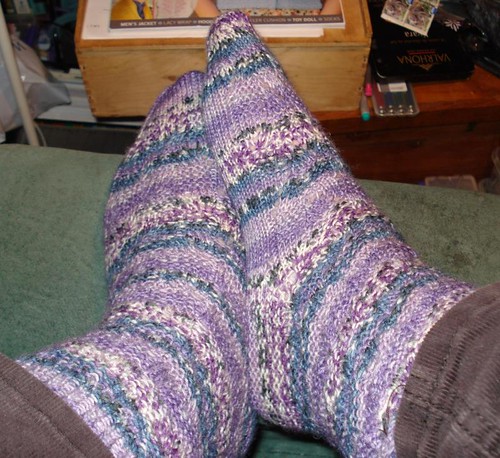Name of Book: Patons: A story of Handknitting
Author: Michael Harvey
Any other info: 0862541174, Springwood Books, 1985
Comments: this is a joint history of Patons the company and knitting in general, looking at some histories and trends, particularly as it impacts the company. It was comissioned by the company so it does have a tendency to emphasise the role of Patons in the industry. Now under the umbrella of Coats Crafts (a merger that dates back to 1961 and was formerly Coats Patons Ltd.) which also includes Viyella; Tootal; William Briggs; Rowan and Jaeger; Regia; Gedifra; Prym and Anchor are some of the other titles falling under this umbrella group but much of this later mergers aren't part of this book, as they post-date this book.
The original companies of Baldwin and Patons had been going since the 1770's and built themselves up until they merged. Forming a worldwide group spinning wool and making items from it.
While written by an academic it is dependent on available research so it's short piece about Aran knitting is infected by the Kiewe virus the author also notes that "It is interesting to note that some authentic Aran ganseys have horizontal bands of pattern, but though there are many variations in complexity and stitch arrangement, traditional Aran design has a unique and distinct flavour."p 110
Chapter 11 on knitting around the coastline and traditional knitted garments was an interesting read. The photographs are also interesting.
The postscript also makes for interesting reading. Writing at a time knitting was somewhat on the wane, when there were still people knitting as a way of saving, rather than today where pre-made goods are cheaper than hand-knitting and it's more a hobby than a necessity. In a pre-internet world he talks about using Teletext to transmit patterns and how it's an unexplored territory with potential. He also talks about television and knitting, something that is only really being re-explored in the US. His identification of Women's magazines as a staple of knitting pattern highlighting is no longer as valid as it was though recent flurries in the Letters Pages of the Irish-based Women's Way about the removal of the Knitting pages shows how essential it is to some people.
He also talks about how well entrenched the woolshop had become, something that over the next decade or so waned and how mail order was important, something that the internet also changed greatly.
He also states "Moving on to the social aspect, knitting equipment can be carried in a small bag and knitting can take place anywhere with little inconvenience - knitting is mobile. It is socially acceptable to do almost anywhere in non-formal, and even in some formal, gatherings. People can chat and knit, listen and knit, and travel and knit. Women's organisations give an impetus to knitting. People will knit for charity, blankets for the deprived in developing countries, sponsored 'knit-ins' - the satisfaction in all this is great and at the same time others are being helped." (p144) Sometimes even as things change they stay the same.
He also says "Concerning psychological factors, knitting is said to have a therapeutic effect. It is soothing and can help one relax, assuming the knitter does not select too complicated a set of instructions to follow. Above all there is the need many have to create, and knitting is creative. Choice of design, colour selection, knitting the fabric and the final product are the creation of the knitter, which leads to a great satisfaction being obtained from the completed garment." You only need to look at some projects on Ravelry, or indeed on the Knitting Elizabeth project to see how different people play with the same concept and how most of them produce something with variations, no matter how subtle. The concept that knitting is creative needs more emphasis!
Overall it's an interesting read, a slice of history of knitting in the UK and actually well complimented by No Idle hands which has a deeper look at knitting from a US point of view.
Buy/Borrow: If you're interested in history, read this one, it's available second hand in places, I got the copy I read from Dun Laoghaire/Rathdown libraries, and I have a sneaking suspicion that it's the only copy I could find in Borrowbooks. A slice of the knitting world that's quite interesting but focused on one company/supplier rather than several.
Where found: Dun Laoghaire Rathdown should have got their copy back ages ago from me, I've been bold. It's going back now.


